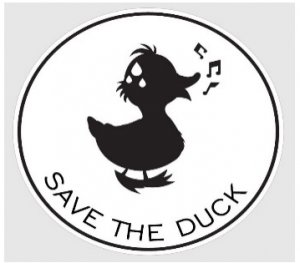Registering and using a trade mark representing an animal is a common practice in the clothing industry. Consequently, proprietors often oppose younger signs which show the same animal. We can for example think of the famous crocodile of Lacoste and all the disputes related to its protection over decades.
A recent judgment by the General Court of 15 July 2020 (T-371/19; available in French and Italian) brings up a new example. This time the animal at issue was a duck. By that ruling the Court confirmed the existence of a likelihood of confusion between the signs in dispute, in part because of the highly distinctive character of the earlier mark, although it disagreed with the Board of Appeal of the EUIPO on the assessment of the conceptual similarity.
In the commented case, the applicant (Itinerant Show Room Srl) filed the EUTM application for a word/figurative sign shown below in Classes 18 and 25:

The opponent (Save the Duck SpA) filed an opposition based, in particular, on its prior word/figurative EUTM shown below registered in Classes 18 and 25:

The ground for opposition was Article 8(1)(b) EUTMR related to the likelihood of confusion. The Opposition Division upheld the opposition and the Board of Appeal rejected the appeal.
The complaint before the General Court relied on the comparison between the signs at issue and the overall assessment of the likelihood of confusion. The Court agreed with the Board that the marks were visually similar to an average degree because of a similar graphic element of a duck, taken into account its black colour, silhouette and size, as well as the common verbal element DUCK. The Court also agreed that the signs were aurally highly similar.
The Court did not however share the appreciation of the conceptual similarity made by the Board which considered that the marks were similar to a high degree. When assessing conceptual similarity all the distinctive elements of the signs in dispute need to be taken into account. Admittedly, in this case both marks show a graphic representation of a duck as well as the word DUCK which strengthens their conceptual closeness. However, they also use different verbal elements: SAVE and FAKE. In this regard, the Board adopted a far-reaching argumentation, noting that even if their individual meaning was different, the verbal elements read together had a close meaning since the expression SAVE THE DUCK corresponded to the decision of the trade mark proprietor to replace duck feathers with synthetic fibres. Thus, the consumer could associate the terms FAKE and DUCK used in the mark applied for with the idea of ‘false duck feather’ and hence with the idea of saving ducks. The Court rejected this very sophisticated motivation, stressing the different meaning of the words SAVE and FAKE, and concluded that the conceptual similarity between the signs was only average.
In the overall assessment of the likelihood of confusion, the Court emphasised the highly distinctive character of the prior mark related to its intensive use and reputation.
This last factor seems to have been of particular importance. Indeed, when two marks show the same animal they are, in principle, always conceptually similar, or even identical if the representation of the animal in question is their sole distinctive element. In many cases, such marks are also visually similar to some extent. However, it does not mean, even if the goods are identical, that there must exist a likelihood of confusion. In this context, it is worth recalling a paragraph of the famous judgment in the Sabel/Puma case (CJEC, 11 November 1997, C-251/95; also concerning a mark showing an animal registered for clothing), surprisingly not referred to in the commented ruling, according to which: ‘It is not impossible that the conceptual similarity resulting from the fact that two marks use images with analogous semantic content may give rise to a likelihood of confusion where the earlier mark has a particularly distinctive character, either per se or because of the reputation it enjoys with the public. However, (…) where the earlier mark is not especially well known to the public and consists of an image with little imaginative content, the mere fact that the two marks are conceptually similar is not sufficient to give rise to a likelihood of confusion’ (paras 24-25). The idea is that the proprietor of the prior mark should not have exclusivity over the use of a generic representation of a particular animal. In such cases, the conceptual closeness, and even identity, together with some visual similarity of the signs, and the identity of the goods, is not sufficient if the prior mark is not particularly distinctive.
_____________________________
To make sure you do not miss out on regular updates from the Kluwer Trademark Blog, please subscribe here.


